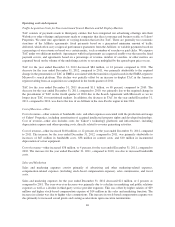Yahoo 2012 Annual Report Download - page 50
Download and view the complete annual report
Please find page 50 of the 2012 Yahoo annual report below. You can navigate through the pages in the report by either clicking on the pages listed below, or by using the keyword search tool below to find specific information within the annual report.
For the year ended December 31, 2011, adjusted EBITDA decreased $56 million, or 3 percent, compared to
2010, due to a decline in revenue year-over-year offset by a decline in operating costs. The decrease in revenue
was primarily attributable to a decline in search revenue. The decline in operating costs year-over-year was
attributable to a decline in search TAC resulting from the required change in revenue presentation for
transitioned markets in the fourth quarter of 2010 due to the Search Agreement with Microsoft described under
“Significant Transactions” below as we no longer incur search TAC for transitioned markets.
Free Cash Flow (a Non-GAAP financial measure)
Years Ended December 31,
2010 2011 2012
(dollars in thousands)
Net cash provided by (used in) operating activities .................. $1,240,190 $1,323,806 $(281,554)
Acquisition of property and equipment, net .................... (714,078) (593,294) (505,507)
Dividends received from Yahoo Japan ........................ (60,918) (75,391) (83,648)
Excess tax benefits from stock-based awards ................... 131,061 70,680 35,844
Free cash flow(*) .................................... $ 596,255 $ 725,801 $(834,865)
(*) Excluding the impact of the cash taxes paid of $2.3 billion related to the Initial Repurchase described under
“Significant Transactions” below, free cash flow for the year ended December 31, 2012 would have been
$1.4 billion.
For the year ended December 31, 2012, free cash flow decreased $1.6 billion, compared to 2011. Excluding the
impact of the cash taxes paid of $2.3 billion related to the Initial Repurchase described under “Significant
Transactions” below, free cash flow increased $705 million due to an increase in net cash provided by operating
activities. Free cash flow for the year ended December 31, 2012 included a payment of $550 million from
Alibaba Group in satisfaction of certain future royalty payments under the existing technology and intellectual
property license agreement with Alibaba Group.
For the year ended December 31, 2011, free cash flow increased $130 million, or 22 percent, compared to 2010.
The increase was primarily attributable to a decline in capital expenditures and an increase in net cash provided
by operating activities.
Non-GAAP Financial Measures
Revenue ex-TAC. Revenue ex-TAC is a non-GAAP financial measure defined as GAAP revenue less TAC. TAC
consists of payments made to Affiliates that have integrated our advertising offerings into their sites and
payments made to companies that direct consumer and business traffic to Yahoo! Properties. Based on the terms
of the Search Agreement with Microsoft described under “Significant Transactions” below, Microsoft retains a
revenue share of 12 percent of the net (after TAC) search revenue generated on Yahoo! Properties and Affiliate
sites in transitioned markets. We report the net revenue we receive under the Search Agreement as revenue and
no longer present the associated TAC. Accordingly, for transitioned markets we report GAAP revenue associated
with the Search Agreement on a net (after TAC) basis rather than a gross basis. For markets that have not yet
transitioned, revenue continues to be recorded on a gross basis, and TAC is recorded as a part of operating
expenses.
We present revenue ex-TAC to provide investors a metric used by us for evaluation and decision-making
purposes during the Microsoft transition and to provide investors with comparable revenue numbers when
comparing periods preceding, during and following the transition period. A limitation of revenue ex-TAC is that
it is a measure which we have defined for internal and investor purposes that may be unique to us, and therefore
it may not enhance the comparability of our results to other companies in our industry who have similar business
arrangements but address the impact of TAC differently. Management compensates for these limitations by also
relying on the comparable GAAP financial measures of revenue and total operating expenses, which include
TAC in non-transitioned markets.
36
























